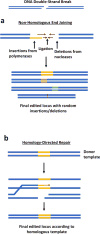Combining Engineered Nucleases with Adeno-associated Viral Vectors for Therapeutic Gene Editing
- PMID: 29130152
- PMCID: PMC5702533
- DOI: 10.1007/978-3-319-63904-8_2
Combining Engineered Nucleases with Adeno-associated Viral Vectors for Therapeutic Gene Editing
Abstract
With the recent advent of several generations of targeted DNA nucleases, most recently CRISPR/Cas9, genome editing has become broadly accessible across the biomedical community. Importantly, the capacity of these nucleases to modify specific genomic loci associated with human disease could render new classes of genetic disease, including autosomal dominant or even idiopathic disease, accessible to gene therapy. In parallel, the emergence of adeno-associated virus (AAV) as a clinically important vector raises the possibility of integrating these two technologies towards the development of gene editing therapies. Though clear challenges exist, numerous proof-of-concept studies in preclinical models offer exciting promise for the future of gene therapy.
Keywords: AAV; CRISPR/Cas9; Gene editing; Gene therapy; Zinc-finger nuclease.
Figures

Similar articles
-
AAV Vectorization of DSB-mediated Gene Editing Technologies.Curr Gene Ther. 2016;16(3):207-19. doi: 10.2174/1566523216666160602213738. Curr Gene Ther. 2016. PMID: 27280971 Review.
-
Therapeutic genome editing with engineered nucleases.Hamostaseologie. 2017 Jan 31;37(1):45-52. doi: 10.5482/HAMO-16-09-0035. Epub 2017 Jan 10. Hamostaseologie. 2017. PMID: 28070592 Review.
-
A multifunctional AAV-CRISPR-Cas9 and its host response.Nat Methods. 2016 Oct;13(10):868-74. doi: 10.1038/nmeth.3993. Epub 2016 Sep 5. Nat Methods. 2016. PMID: 27595405 Free PMC article.
-
Basics of genome editing technology and its application in livestock species.Reprod Domest Anim. 2017 Aug;52 Suppl 3:4-13. doi: 10.1111/rda.13012. Reprod Domest Anim. 2017. PMID: 28815851 Review.
-
CRISPR/Cas9-mediated genome engineering: an adeno-associated viral (AAV) vector toolbox.Biotechnol J. 2014 Nov;9(11):1402-12. doi: 10.1002/biot.201400046. Epub 2014 Oct 6. Biotechnol J. 2014. PMID: 25186301
Cited by
-
Genomics in medicine: A new era in medicine.World J Methodol. 2021 Sep 20;11(5):231-242. doi: 10.5662/wjm.v11.i5.231. eCollection 2021 Sep 20. World J Methodol. 2021. PMID: 34631481 Free PMC article.
-
Efforts to Downsize Base Editors for Clinical Applications.Int J Mol Sci. 2025 Mar 6;26(5):2357. doi: 10.3390/ijms26052357. Int J Mol Sci. 2025. PMID: 40076976 Free PMC article. Review.
-
In vivo genome editing in animals using AAV-CRISPR system: applications to translational research of human disease.F1000Res. 2017 Dec 20;6:2153. doi: 10.12688/f1000research.11243.1. eCollection 2017. F1000Res. 2017. PMID: 29333255 Free PMC article. Review.
-
The Role of Recombinant AAV in Precise Genome Editing.Front Genome Ed. 2022 Jan 13;3:799722. doi: 10.3389/fgeed.2021.799722. eCollection 2021. Front Genome Ed. 2022. PMID: 35098210 Free PMC article. Review.
-
Aspects of Gene Therapy Products Using Current Genome-Editing Technology in Japan.Hum Gene Ther. 2020 Oct;31(19-20):1043-1053. doi: 10.1089/hum.2020.156. Epub 2020 Sep 17. Hum Gene Ther. 2020. PMID: 32731837 Free PMC article. Review.
References
-
- Bainbridge JWB, Smith AJ, Barker SS, et al. Effect of Gene Therapy on Visual Function in Leber’s Congenital Amaurosis. N Engl J Med. 2008;358:2231–2239. - PubMed
Publication types
MeSH terms
Substances
Grants and funding
LinkOut - more resources
Full Text Sources
Other Literature Sources
Medical

